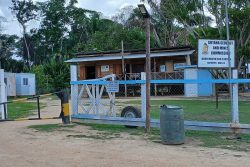Dear Editor,
A special thanks must go out to our two ministers who visited Lethem over the weekend. Due to their presence Lethem experienced the rare luxury of three nights of uninterrupted electricity supply. It seemed that it took the visit of these eminent guests for the Lethem Power Company to resolve it supply woes.
But what about the long-term energy plan for Lethem? The official opening of the Takutu Bridge is getting nearer (or at least we hope so) and there will be demand for energy. Where will this be coming from? The present electricity supply is woefully inadequate and breaks down very frequently. Even the supply network is said to be collapsing because of lack of maintenance. When will all these problems be tackled? Will we wait until after the bridge is officially open and energy is in demand before we tackle our problems?
Our government seems to think that providing a reliable supply of electricty is a simple undertaking which will happen overnight. Will we embarrass ourselves again, as with the bridge, when everyone assumed the bridge was ready to open, not least our Brazilian neighbours, only to realise that our government forgot to install the necessary infrastructure in Lethem?
The main reason for the ministers’ visit to the Rupununi was to promote the government’s ‘Low Carbon Development Plan.’ Part of this plan is to make Guyana utilise ‘cleaner’ electricity by way of hydroelectricity. But the cost attached to developing hydroelectricity is astronomical and would most likely be above our country’s means.
But what about considering a plan to utilise hydroelectricy from Venezuela, via Brazil? It is said that the Guri Dam in Venezuela has surplus electricity that can easily cover all of Guyana’s needs. This hydroelectricity is right at our border edge at Bon Fim. It was even said that the Governor of the state of Roraima in Brazil offered this electricity to Lethem when the Moco Moco hydro broke down. But alas, our government did not think this was necessary and Lethem’s electricity has gone downhill ever since.
Now that our President is leading the march for lower carbon emissions by utilising clean energy, would he reconsider Brazil’s offer of hydroelectricity to Lethem and possibly the entire country? The benefits for giving this proposal consideration seem numerous.
Firstly, we do not have to undertake the costs to design and construct the hydro dam. Secondly, the electricity is already at the border of our country at a point which our government considers a key long-term development location. Thirdly, if a network is developed along the road from Lethem to Georgetown then we would be killing many birds with one stone. We would already have an accessible road along which to run our electricity lines. The road will, by necessity, have to be in excellent condition. Providing electricity along the road would make it easier for development to occur along this corridor. Fourthly, our country does not have to worry about any possible environmental disaster such as dam failure since the dam isn’t in our country. Fifthly, and possibly most importantly, the time-frame to convert to clean energy would be much shorter, thus meeting the criteria of reducing carbon emissions in the shortest possible time-frame.
So what really has made our government ignore this offer of hydroelectricity from Brazil? Well, that is what baffles everyone! No matter how you look at it, it seems that Guyana would have selected a winner if they had agreed.
One only hopes that our two ministers who visited the Rupununi to promote the government’s low carbon emissions, report to the President that constructing a hydro dam is not the only way that Guyana can access hydroelectricity. There may be a plan whose overall benefits far exceed that of constructing a dam at Amaila Falls, one that may be cheaper and faster to implement. If that be the case, then our government should put what they are preaching at these consultations into practice, and give this option serious consideration.
Yours faithfully,
(Name and addressprovided)








